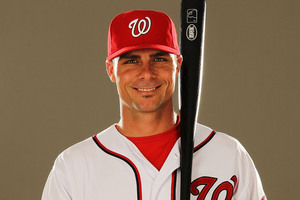
Is Ankiel the solution for the Nats in center field? Photo by Al Bello/Getty Images via federalbaseball.com
Editors note: I was out of town last weekend and had this queued up but never hit publish :-).
MLB’s Nationals beat writer Bill Ladson hasn’t done an inbox for a few weeks, probably because he’s been busy at spring training. Now that the regular season has started and we’ve had some debatable 25-man roster decisions made, he has published another edition of his Inbox column. Here’s how i’d answer the questions he selects…
Q: What are you most worried about with the Nationals in 2011?
A: I’d say, in order, offense, the starting rotation, center field, and the back end of the bullpen. I feel like we took a step backwards in terms of offense, we have improved the rotation over last year but still would probably rank this rotation 28th or 29th in the league, that Rick Ankiel in center field doesn’t really help us a ton, and that Drew Storen had such a rough spring that our end-of-game scenarios may be challenging.
Q: How do you think the Nationals will fare this season in the National League East with their off-season signings?
A: Probably the same as last year; last place. Philadelphia and Atlanta are probably playoff bound no matter how many injuries the Phillies sustain. Florida is probably taking a step side ways, having lost Uggla but picked up Vazquez (honestly, I don’t see how their fans don’t revolt at their perennial 87 win team doesn’t spend the $10 needed to improve themselves to be a 92 win team and challenge for the wild card). The Nats may finish above the Mets, if only because that franchise is in such disarray right now. They’re eating more than $20M in salary for players they’ve already released, they made no significant off-season moves and there’s serious injury question marks around 4 of their 5 best paid players (Santana, Beltran, Bay and Francisco Rodriguz). I can see that time imploding badly and the Nats sneaking ahead of them for 4th place, maybe.
Q: If Bryce Harper has an amazing year in the Minors, is there a chance he will get a Major League callup?
A: They shouldn’t … but they may. I would not be surprised to see the kid rocket through low-A and high-A ball. It would be purely a late-season revenue grab to call him up, but they need to be careful on his service time accrual. If he plays 30 days in September we’d have to keep him down an extra 30 days in 2012 to ensure he doesn’t become a super-2. For those not clear on the implications of super-2 screwup, read this bit about the mistake the Giants made with Tim Lincecum.
That being said, i’d love to see him playing in the bigs before his 19th birthday. That’d be fantastic. And he may very well earn it. His weakness in the AFL and in spring training was offspeed pitches, but its hard to fault the kid for wanting to swing and make something happen in the limited time he’s seen. Once a full season gets going and he’s getting 4 ABs every night, he will learn patience, he will earn walks as pitchers work around him, and he’ll pick his spots. This, more than anything else, is the lesson he needs to learn to advance in the minors.
Q: Do we see a parallel developing between Roger Bernadina and Justin Maxwell? How long do we have to wait?
A: It isn’t a bad parallel to note. Bernadina lost the LF job, then the CF job, then the 4th outfielder job to a non-roster invitee. He’s burning his last option as we speak. He has a career 80 OPS+. I openly questioned in this space why he was the presumed starter in LF all off-season, and as it turned out I was right about Morse being the better player. I think he’ll play out the string in AAA this year and get traded for a low-level minor leaguer at the end of spring training 2012, just as we did with Morgan and Gonzalez this week.
Q: What do you think of the job general manager Mike Rizzo and manager Jim Riggleman have done since they took over in 2009?
A: I think Rizzo has done a decent job with the major league team and a pretty good job with the farm system. I feel like he’s tried a little TOO hard to rid the team of the non-defensive hitters Willingham and Dunn, and could have gotten more for them. I understand the Werth signing but think (like the rest of baseball) that he overpaid and strangely backloaded the contract (why back load instead of front load? We’re actually at LESS payroll this year than last, so we could be paying him $20M this year instead of $10M and still look like we’re treading water). He’s definitely assembled a team in his vision; defensively gifted, a bullpen full of power arms. Next step; power rotation.
Riggleman is doing the best with what he has; I don’t believe other managers could do much better. Most people believe we have probably the 28th or 29th best collection of talent in the majors, but we’re achieving better than 29th place.
Q: Besides Harper, which rookie impressed you during Spring Training?
A: I cannot disagree with Ladson’s selection of Cole Kimball as “most impressive rookie.” I would not be surprised to see him called up in 2011 and to start getting high-leverage appearances.